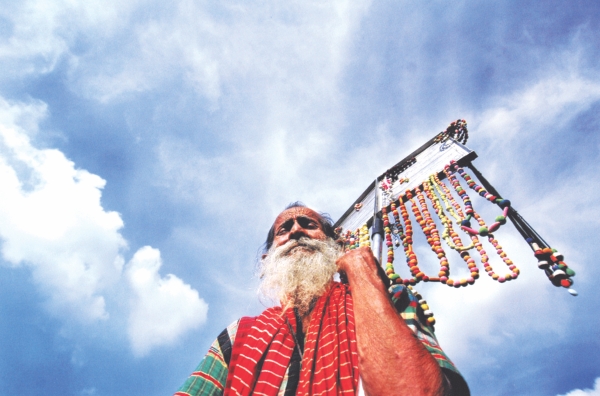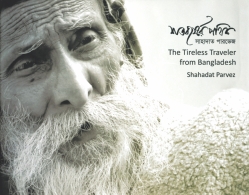| Home - Back Issues - The Team - Contact Us |
 |
| Volume 11 |Issue 25| June 22, 2012 | |
|
|
Photography
Poetry of a Less Known Life Shahadat Parvez's collection of photographs of Charukala's model Momin Ali Mridha is like a lyrical poem recited through the lens Tamanna Khan
Anyone frequently passing by the vicinity of the Faculty of Fine Arts, Dhaka University, more commonly known as Charukala, must have come across Dadu at least once. The old man with a white beard and the aura of a baul, was often seen selling colourful earthen necklaces and earrings, much before they became costly fashion wear sold at branded shops. Like the coming back of cherished memories, Dadu reappears through Shahadat Parvez's lens. His book 'The Tireless Traveler from Bangladesh' rediscovers the old man, bringing forth his name, his past and the philosophy of his life. In the foreword of the book, Parvez relates his initial encounters with Dadu. Like many others, he too was attracted towards this old man, who was easily distinguishable among the city's chaotic crowd. Like many, Parvez did not limit his interaction with Dadu to the purchase of earthen jewellery that Dadu sold. Rather, he had spent time with the old man noting down untold and interesting stories of his life. Through Parvez's book, we come to know how Momin Ali Mridha, born probably in the early twentieth century in a remote village in Shariatpur, was discovered by Shilpacharya Zainul Abedin in the fifties and soon became Charukala's model and everyone's loved Dadu (grandfather). It is interesting to note that, Parvez, currently working as a senior photo journalist in the daily Prothom Alo, chooses to tell the story of a common man, not some celebrity. He picked Dadu, who neither had a title before his name nor any award in his jhola. Though he spent almost half his life modeling for numerous painters and sculptors, many of whom later made a name for their art, Dadu remained behind the limelight. He was however loved and respected by the students and teachers of Charukala as well as many others like Parvez who came to know him more closely. Unlike Charukala's artists, Parvez did not use chisel or brush to depict Dadu's image. His tool was his camera. Over a period of eight years starting from 2005, Parvez presents Dadu at his workplace inside Charukala and outside the institution's wall, selling his hand-made, colourful crafts. Parvez skillfully maintains Dadu's mystique and out-of –the ordinary characteristic throughout the books. His pictures capture the old man's emotions, thoughts and hopes. Parvez is careful in not bringing the reality that perhaps existed beyond Dadu's positive attitude towards the world. Even while introducing Dadu in the foreword, he refrains from sharing personal details which would have made the man just another commoner, working hard to make a living. Thus the artist-cum-photographer restricts his subject within the perimeters of the world he has seen him in. Yet for viewers, the untold stories of Dadu's struggle with life manifest themselves in some photos. For instance, in the photograph taken from a bird-eye angle the old man is seen sitting forlornly with his trade on the public pavement. In another photo, rain blurs the lenses and a fuzzy representation of the old man emerges like a melancholy poem. The poetic and philosophical captions add momentum to the pictures. They almost become lyrical. The photographs are well-choreographed setting the model against different backgrounds and moods. In some of the snaps, the model almost becomes a live element or rather an installation in the backdrop of a canvas or beside a life-size mask. At times, Parvez uses shadows and drops of sunlight to augment his pictures just like an artist plays with different shades of colours. The colourful snapshots celebrate life in each and every page. Even the last picture in monochrome, with the glowing setting sun, speaks of hope as a child is seen pushing a wheel in the opposite direction towards which the enfeebled Dadu walks.
|
||
|

